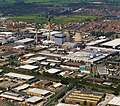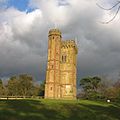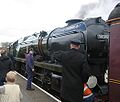The South East England Portal

South East England is one of the nine official regions of England in the United Kingdom at the first level of ITL for statistical purposes. It consists of the nine counties of Berkshire, Buckinghamshire, East Sussex, Hampshire, the Isle of Wight, Kent, Oxfordshire, Surrey and West Sussex. Cities and towns in the region include Aldershot, Ashford, Aylesbury, Basingstoke, Bracknell, Brighton and Hove, Canterbury, Chichester, Crawley, Eastbourne, Farnborough, Gosport, Guildford, Hastings, High Wycombe, Margate, Maidstone, Medway, Milton Keynes, Newport, Oxford, Portsmouth, Ramsgate, Reading, Slough, Southampton, Winchester, Woking and Worthing.
South East England is the third-largest region of England, with a land area of 19,072 square kilometres (7,364 sq mi), and is also the most populous with a total population of over nine million. The region contains eight legally chartered cities: Brighton and Hove, Canterbury, Chichester, Milton Keynes, Oxford, Portsmouth, Southampton and Winchester. The region's close proximity to London has led to South East England becoming a prosperous economic hub with the largest economy of any region in the UK, after London. The region is home to Gatwick Airport, the UK's second-busiest airport, and Heathrow Airport (the UK's busiest airport) is located adjacent to the region's boundary with Greater London. The coastline along the English Channel provides numerous ferry crossings to mainland Europe.
The region is known for its countryside, which includes two national parks: the New Forest and the South Downs, as well as the North Downs, the Chiltern Hills and part of the Cotswolds. The River Thames flows through the region and its basin is known as the Thames Valley. It is also the location of a number of internationally known places of interest, such as HMS Victory in Portsmouth, Cliveden in Buckinghamshire, Thorpe Park and RHS Wisley in Surrey, Blenheim Palace in Oxfordshire, Windsor Castle in Berkshire, Leeds Castle, the White Cliffs of Dover and Canterbury Cathedral in Kent, Brighton Palace Pier, and Hammerwood Park in East Sussex, and Wakehurst Place in West Sussex. The region has many universities; the University of Oxford is the oldest in the English-speaking world, and ranked among the best in the world.
South East England is host to various sporting events, including the annual Henley Royal Regatta, Royal Ascot and The Derby, and sporting venues include Wentworth Golf Club and Brands Hatch. Some of the events of the 2012 Summer Olympics were held in the south east, including the rowing at Eton Dorney and part of the cycling road race in the Surrey Hills.
In medieval times, South East England included much of the Kingdom of Wessex, which was the precursor to the modern state of England. Winchester was the capital of England after unification of the various states, including the kingdoms of Kent, Sussex and Mercia. Winchester stopped being the administrative capital of England some time in the 13th century as its influence waned while the City of London dominated commerce. The last monarch to be crowned at Winchester was Richard II in 1377, although the last monarch to be crowned by the Bishop of Winchester was Queen Mary I in 1553. (Full article...)
Selected article
The Brill Tramway, also known as the Quainton Tramway, Wotton Tramway, Oxford & Aylesbury Tramroad and Metropolitan Railway Brill Branch, was a six-mile (10 km) rail line in the Aylesbury Vale, Buckinghamshire, England. It was privately built in 1871 by the 3rd Duke of Buckingham as a horse tram line to help transport goods between his lands around Wotton House and the national rail network. Lobbying from the nearby village of Brill led to its extension to Brill and conversion to passenger use in early 1872. Two locomotives were bought but trains still travelled at an average speed of 4 miles per hour (6.4 km/h).
In 1883, the Duke of Buckingham planned to upgrade the route to main line standards and extend the line to Oxford, creating the shortest route between Aylesbury and Oxford. Despite the backing of the wealthy Ferdinand de Rothschild, investors were deterred by costly tunnelling. In 1888 a cheaper scheme was proposed in which the line would be built to a lower standard and avoid tunnelling. In anticipation, the line was named the Oxford & Aylesbury Tramroad.
The existing line was upgraded in 1894, but the extension to Oxford was never built. Instead, operation of the Brill Tramway was taken over by London's Metropolitan Railway and Brill became one of its two north-western termini. The line was rebuilt in 1910, and more advanced locomotives were introduced, allowing trains to run faster. The population of the area remained low, and the primary income source remained the carriage of goods to and from farms. Between 1899 and 1910 other lines were built in the area, providing more direct services to London and the north of England. The Brill Tramway went into financial decline.
In 1933 the Metropolitan Railway became the Metropolitan line of London Transport. The Brill Tramway became part of the London Underground, despite Quainton Road being 40 miles (64 km) from London and not underground. London Transport aimed to concentrate on electrification and improvement of passenger services in London and saw little possibility that passenger routes in Buckinghamshire could become viable. In 1935 the Brill Tramway closed. The infrastructure was dismantled and sold. Little trace remains other than the former junction station at Quainton Road, now the Buckinghamshire Railway Centre. (Full article...)
Selected pictures
Selected biography
Dame Ellen Patricia MacArthur DBE (born 8 July 1976) is a retired English sailor, from Whatstandwell near Matlock in Derbyshire, now based in Cowes, Isle of Wight.
MacArthur is a successful solo long-distance yachtswoman. On 7 February 2005, she broke the world record for the fastest solo circumnavigation of the globe, a feat which gained her international renown. Francis Joyon, the Frenchman who had held the record before MacArthur, was able to recover the record again in early 2008.
Following her retirement from professional sailing on 2 September 2010, MacArthur announced the launch of the Ellen MacArthur Foundation, a charity that works with business and education to accelerate the transition to a circular economy. (Full article...)
On This Day in South East England
8 August:
1963: The Great Train Robbery took place at Ledburn in Buckinghamshire.
Categories
Related portals
WikiProjects
Topics
Associated Wikimedia
The following Wikimedia Foundation sister projects provide more on this subject:
-
Commons
Free media repository -
Wikibooks
Free textbooks and manuals -
Wikidata
Free knowledge base -
Wikinews
Free-content news -
Wikiquote
Collection of quotations -
Wikisource
Free-content library -
Wikiversity
Free learning tools -
Wikivoyage
Free travel guide -
Wiktionary
Dictionary and thesaurus
© MMXXIII Rich X Search. We shall prevail. All rights reserved. Rich X Search

































































































































